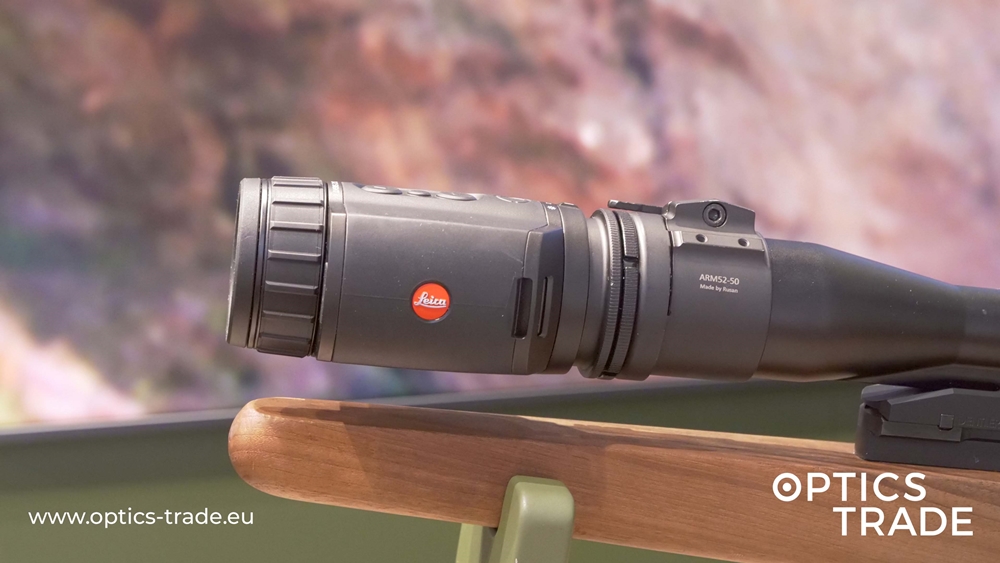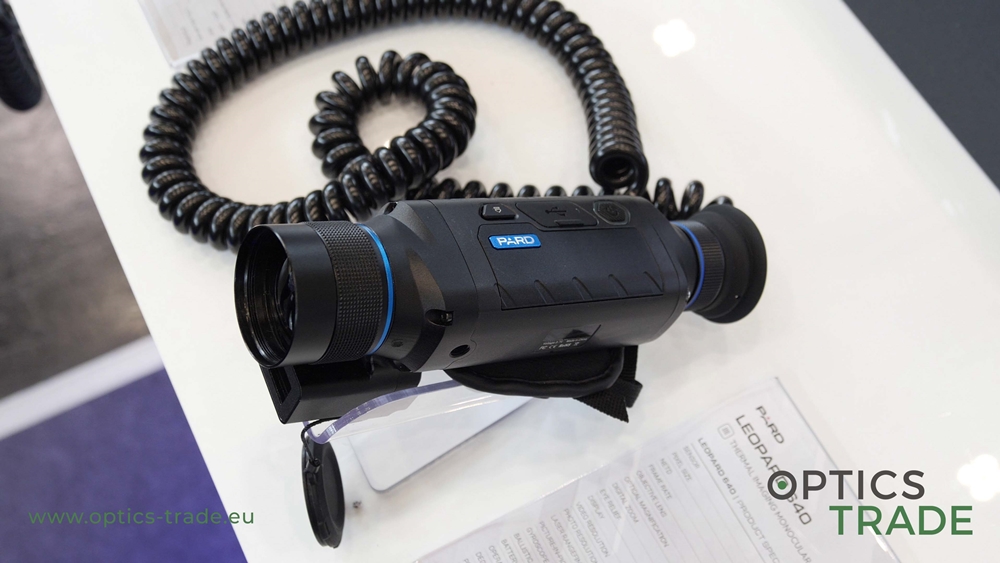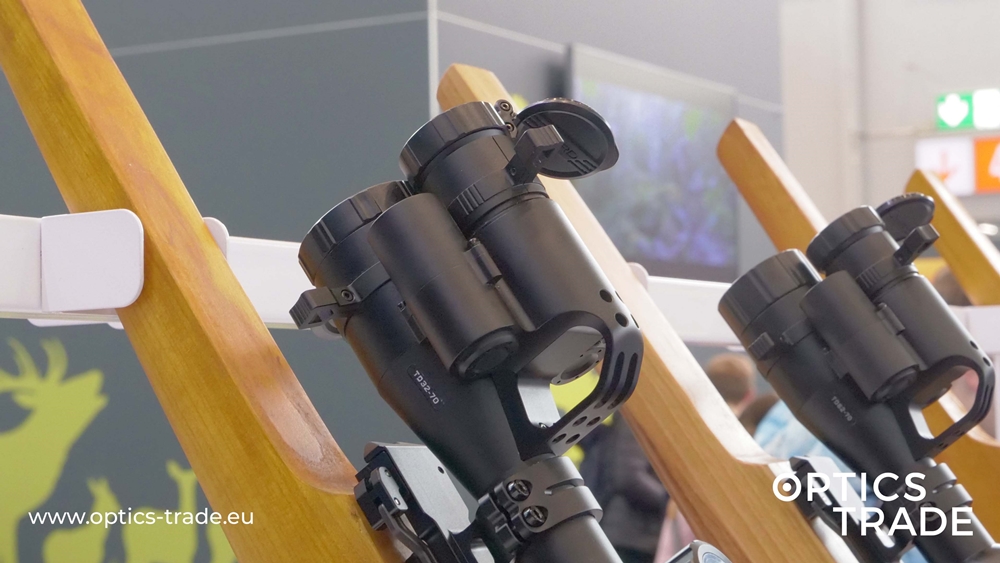Hello and welcome to today’s Optics Trade Debates video. We’re here to discuss a topic that lately sparked a lot of interest. We’ll be talking about thermal and digital night vision optical devices. Since both are used for low light or night vision observations and hunting, many clients have questions about their differences, advantages and how they compare in practice.
Let’s start with focusing on the physical aspects of thermal and digital night vision devices. Both technologies can be found in many different products, such as monoculars, binoculars, clip-ons and rifle scopes. From the outside point of view, thermal and night vision devices are very similar. Both have an eyepiece, objective lens, a thermal or a digital infrared sensor, a battery and an electronics compartment and, perhaps most importantly, a digital display where the image is projected to.
The only immediately visible difference is the infrared illuminator, only featured on the digital night vision devices. Thermal devices do not need an infrared illuminator, they are passive and function without any light emission.
It is important to note that thermal devices can be up to 3 or 4 times more expensive than digital night vision devices. For example, an average price for a digital night vision scope is around 500 euros, which is considerably less than 1500 euros required for a thermal scope variant of comparable size and quality. Even the best digital night vision scopes available on the market rarely surpass the 800-euro mark, while the best thermal cameras can easily cost 4000, 5000 euros or more. Thermal devices work on a different principle, the sensors are much more expensive for the manufacture and that raises the marketed price.
There can be some difficulty in comparing the optical properties of thermal and digital night vision devices since their technologies are so vastly different. However, there is one staggering difference. The range of detection with digital night vision is already maximal at around 400 metres because the infrared illuminators are not powerful enough to illuminate the objects in the line of view beyond that range. Compare that to thermal devices at the most basic, entry-level that already guarantee a detection range of 1 kilometre. When it comes to high-quality thermal devices, this range can extend all the way up to 2 kilometres or more.
The example of an entry-level thermal device used in the video is a Pulsar Thermal Imaging Scope Quantum Lite XQ23V with a range detection of 800 metres. So that’s already twice more than what the best digital night vision devices on the market can provide. Another setback of digital night vision devices and their range is that even if they detect objects beyond 400 metres, they will be difficult to observe.
The range of digital night vision devices can be extended by purchasing a separate illuminator. There is a Picatinny rail on the housing outside of the device, where a powerful infrared illuminator can be attached. Still, even the most efficient illuminators on digital night vision devices won’t match the detection ranges of thermal devices.
The third major difference is that weather conditions and physical obstacles are not an issue when using thermal devices. The individual will be able to see past the rain, fog, greenery or even nature elements such as branches or trees because there will be a stark colour contrast between the body temperature of living creatures and the backdrop.
The efficiency of digital night vision devices with a separate infrared illuminator, on the other hand, will be compromised in difficult weather situations and when surrounded by obstacles. This is because all of these reflect the infrared light, beaming from the illuminator, right back.
There’s another thing. With thermal devices, the user is able to see only the warm body parts of the animal. Digital night vision devices, however, will display the entire animal, making it easier to judge the trophy. Let’s use the example of red deer hunting. Important body parts of the animal like the antlers will only be shown on digital night vision displays, while the thermal device users will have to get closer (to approximately 60-70 metres).
Contrary to the popular belief, the gender of the trophy can be determined with the use of a thermal device (although, this largely depends on the species in question). There shouldn’t be too much of a problem when observing a passel of wild hogs. Of course, the better the quality of the sensor, the easier it is to recognize the difference between males and females. The gender of the observed animals is effortlessly detectable with the use of digital devices.
Now let’s summarise the main points of this debate. The positives of digital night vision devices are the cheaper price, a higher resolution compared to thermal devices where the front sensor has a very low resolution. There is an advantage in being able to see the entire animal at a longer distance than with a thermal imaging device. Lastly, gender detection is made easy with digital night vision devices.
The biggest advantage of the thermal devices is the range of detection. They work well under any weather conditions and in areas with obstacles. Combined, that means the user of thermal devices will be able to spot animals much faster. The obvious disadvantage is the price.
As we established, thermal and digital night vision devices are incredibly different due to the technology employed for their function. This is why we believe that the optimal compromise is to purchase a combination of both. It’s best to purchase a digital night vision device used for observation and rely on a thermal clip-on for shooting. Or it can be the other way around, of course.
Soon, the analog digital night vision devices could be entirely replaced by thermal devices. However, in the distant future (in a decade or so), fusion devices could replace every option available on the market today. That means that one device will provide both channels and a combined picture will show the best of both worlds. Some devices of this nature have already been developed, with companies like Photonis and General Starlight Company Inc. leading the race.
We finally arrived at the end of our debate. If you have any questions left or would like to know more about this extensive topic, feel free to contact us via email or visit our webpage for more information. You can also leave a comment down below, like the video and please subscribe to this Youtube channel. We’ll see you next time!





Hat’s Off Boss!
got many knowledge about thermal scopes. i know Thermal release infrared energy that cannot be detected by the naked eye. Whatever, if any one has ability to buy thermal then i recommend them to buy thermal instead of digital night vision scopes. specially if you are a hunting lover.
Extremely helpful review! I’m wanting to purchase the best night vision scope but this review made that job much easier. Just a question on the battery life of these scopes, should I be concerned about it? I’ve read about the ATN X-Sight 4K Pro that has a battery life of 18 hours (https://www.pointoptics.com/best-night-vision-scope/). I definitely don’t want the scope to die in the middle of the night. Will the thermal scope be more effective than the digital scope in terms of battery life? Thanks for the help
Great, I was trying to learn about night vision, an I was lucky enough to find this page.
Hi, Thanks so much for your explanation. I had been searching for the night vision device and had the intention to buy one but after reading your article, I found that buying hunting tools is a long term and I’ll give it a try.
There is a significant amount of misinformation regarding the use of “Generations” to describe night vision image intensifier tubes (e.g., Gen 0, Gen I, Gen II, Gen III and Gen +) especially when addressing their capabilities and limitations. The US Department of Defense (DoD) de-emphasized the use of the term “generation” as a determinant factor of a tube’s performance. The term generation in today’s environment only refers to the material used in the photocathode, i.e., Multi-Alkaline for Gen II, or Gallium Arsenide for Gen III. Gen III makes use of ion barriers, however it’s because of the use of Gallium Arsenide – not because it’s a massive technological advancement in tube performance. What that means is that a Gen III tube is not necessarily “better” than a Gen II. The advanced Multi-Alkaline tubes of 2018 are vastly improved in performance so that today very little comparison can be made between the two generations, which in turn, has affected the way the military grades tubes. Image intensifier tubes are now graded by performance in their Signal to Noise Ratio (SNR), Resolution, Halo, and Gain, with Figure of Merit (FOM) being the main differentiator. FOM is calculated by multiplying the SNR by Resolution. FOMs greater than 1600 are restricted for export from the USA while FOMs exceeding 1600 or higher are generally restricted to the USA and/or police/military only. With regard to the military specifications in each category, the modern Gallium Arsenide or Multi-Alkaline tube meets or exceeds the current requirements for FOM, SNR, resolution, and gain required by the DoD. In common usage, a night vision device said to be “a FOM 1600 system” will have a tube performance less than or equal to 1600.
Another item addressed is the service life of a tube. Stating that a Gen III tube has a longer service life than a Gen II tube is no longer the case with modern Multi-Alkaline (“Gen II”) image intensifier tubes. DoD requirements are for 10,000 hours of service life for a night vision tube and modern Multi-Alkaline tubes meet this requirement.